
How to Change Human Behavior - H. R. Beech
How to Change Human Behavior: A Practical Guide to Influencing Others
Introduction
In his book, "How to Change Human Behavior," H. R. Beech provides a comprehensive and practical guide to understanding and influencing human behavior. Drawing on decades of research and experience, Beech offers a wealth of insights and strategies for effectively changing the behavior of individuals and groups.
Understanding Human Behavior
The first step to changing human behavior is understanding the factors that influence it. Beech explores the various psychological, social, and environmental factors that shape our behavior, including:
- Personality traits: Our unique personality traits play a significant role in our behavior. Understanding these traits can help us predict and influence how people will respond to different situations.
- Attitudes and beliefs: Our attitudes and beliefs are powerful drivers of our behavior. Changing these attitudes and beliefs can lead to lasting changes in behavior.
- Social norms: The social norms of our culture and environment can have a profound impact on our behavior. Understanding these norms can help us identify and leverage social pressure to encourage desired behaviors.
- Environmental factors: The physical and social environment in which we live can also influence our behavior. Making changes to our environment can help us create conditions that support positive behaviors.
Techniques for Changing Behavior
Once we understand the factors that influence human behavior, we can begin to apply effective techniques for changing it. Beech presents a variety of strategies, including:
- Positive reinforcement: Rewarding desired behaviors can increase the likelihood that they will be repeated.
- Negative reinforcement: Removing or avoiding unpleasant consequences can also increase the likelihood of desired behaviors.
- Punishment: Punishing undesirable behaviors can decrease the likelihood that they will be repeated.
- Extinction: Ignoring undesirable behaviors can eventually lead to their extinction.
- Modeling: Observing others performing desired behaviors can increase the likelihood that we will adopt those behaviors ourselves.
- Cognitive-behavioral therapy: This type of therapy helps individuals identify and change negative thought patterns and behaviors.
Applying Behavior Change Strategies
Beech provides detailed guidance on how to apply these behavior change strategies in a variety of settings, including:
- The workplace: Managers and leaders can use behavior change strategies to improve employee performance, motivation, and teamwork.
- The classroom: Teachers can use behavior change strategies to create a positive learning environment and encourage student success.
- The home: Parents can use behavior change strategies to raise well-behaved and responsible children.
- The community: Community leaders can use behavior change strategies to promote public health, safety, and well-being.
Conclusion
"How to Change Human Behavior" is an essential resource for anyone who wants to understand and influence human behavior. Beech's practical and evidence-based approach provides a wealth of insights and strategies for effectively changing the behavior of individuals and groups. Whether you're a manager, teacher, parent, or community leader, this book will give you the tools you need to create positive change.
Call to Action
If you're ready to learn more about how to change human behavior, order your copy of "How to Change Human Behavior" today. This comprehensive and practical guide will help you understand the factors that influence behavior and provide you with the strategies you need to create lasting change.